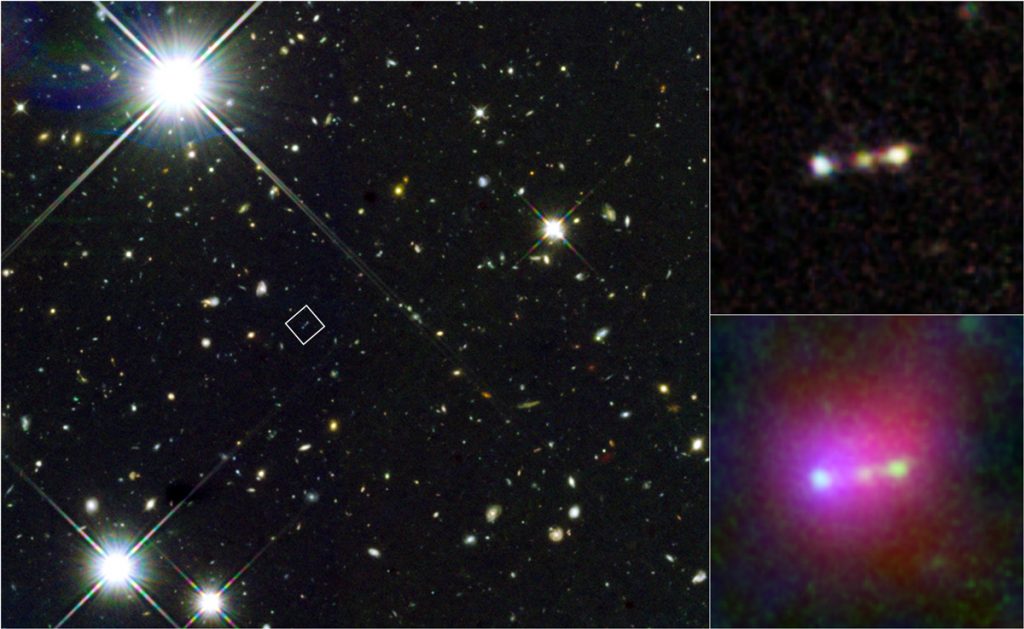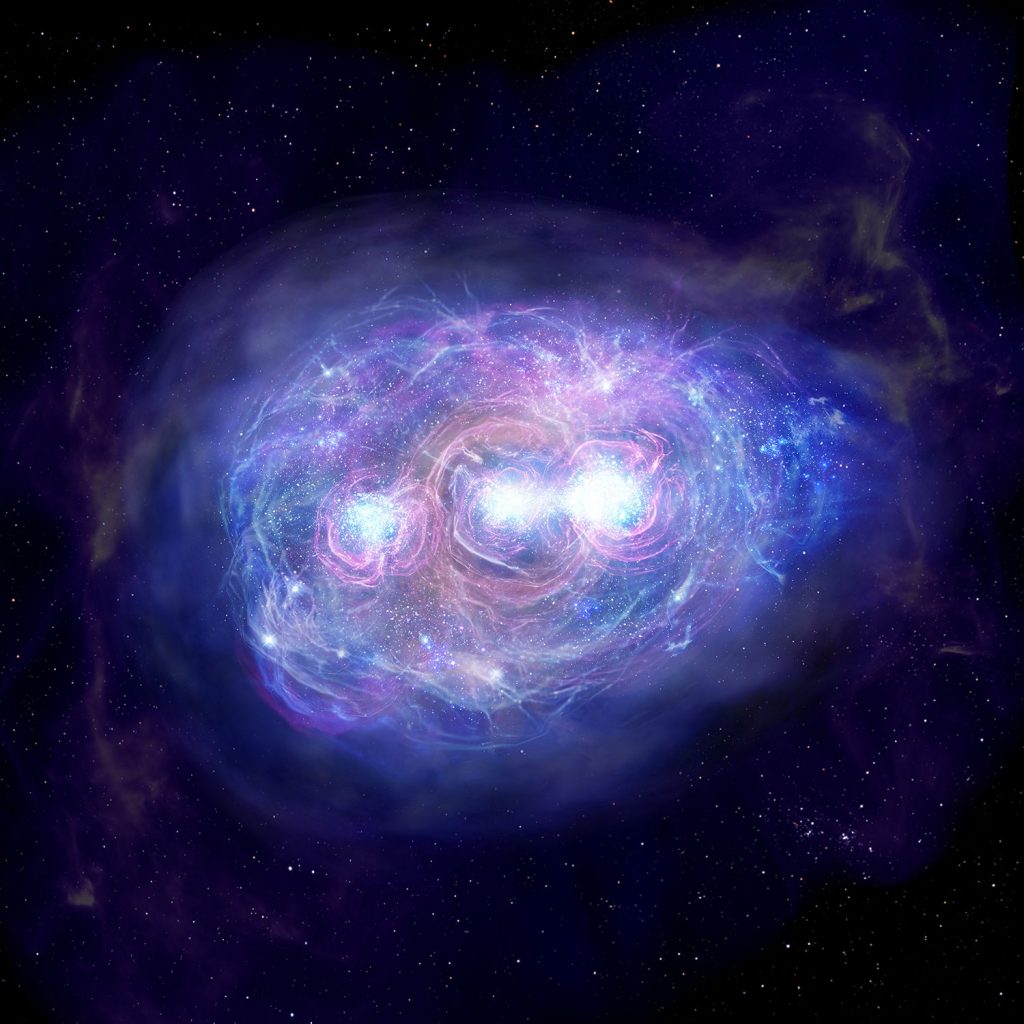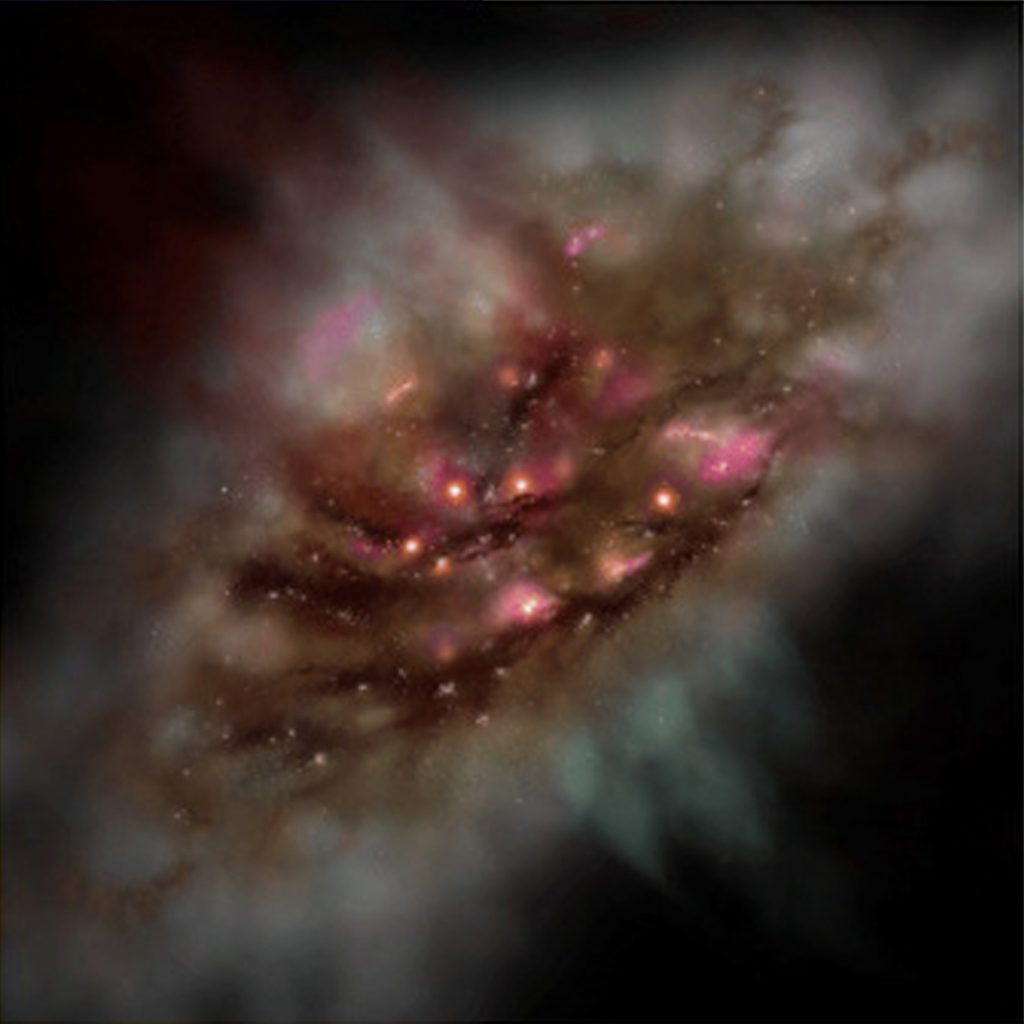Using Hubble Space Telescope and instruments on the Atacama Large Millimeter/Submillimeter Array (ALMA), ICRR Associate Professor and Kavli IPMU Scientist Masami Ouchi and his collaborators have explored the physical nature of a remarkable giant `space blob’ first discovered using the Subaru telescope on Mauna Kea, Hawaii. The new observations reveal a complex structure suggestive of a rare triple merger and, most surprisingly, the absence of heavy chemical elements indicating its primitive nature. The giant blob, named `Himiko’ (after a legendary mysterious queen in ancient Japan), is being seen when the Universe was only 800 million years old, corresponding to 6% of its present age. The observations provide valuable insight into the earliest stages of galaxy formation at a time termed `Cosmic Dawn’ when the Universe was first bathed in starlight.
The remarkable properties of Himiko were first realized in 2009 when a deep image taken with the Subaru telescope revealed a hot glowing gaseous halo extending over 55 thousand light years, about 10 times larger than typical galaxies at the epoch of Himiko and comparable to the radius of our own Milky Way. Corresponding infrared observations with the Spitzer Space Telescope unveiled a massive galaxy, equivalent to tens of billions of suns, much larger than other objects seen at a similar epoch. Astronomers speculated that Himiko was being seen at a special moment in its history, perhaps in the process of being formed from a large gas cloud or during the collision of two large young galaxies. The biggest puzzle was the source of energy for the vast glowing gas cloud.
Both Hubble Space Telescope and ALMA have exquisite resolution and sensitivity and the combination has been very effective in probing the nature of this mysterious object. “We have performed the deepest and most sensitive observations of Himiko with an angular resolution unmatched by earlier work. These observations have successfully addressed the puzzling nature of Himiko, but brought some new surprises!” explains first author Masami Ouchi, an associate professor at the University of Tokyo who led an international team of astronomers from Japan and the United States. “The Hubble data shows that Himiko harbors three bright clumps, whose intense star formation likely powers the giant cloud of gas. However, a new mystery revealed by ALMA is the absence of carbon, which is rapidly synthesized in young stars. Exactly how this intense activity can be reconciled with the primitive chemical composition of Himiko is a new puzzle”
The Hubble images (see Figure 1) reveal three stellar clumps aligned over 20 thousand light years. Each clump has a brightness comparable to a typical luminous galaxy at the epoch of Himiko, when the Universe was only 800 million years old. The gigantic hydrogen cloud (or space blob) engulfs the three clumps. No single bright core is found, ruling out the possibility that Himiko is powered by a super massive black hole.
“The Hubble images confirm that we are seeing a triple merger – a remarkably rare event”, added Richard Ellis, a team member at the California Institute of Technology. “Moreover the three clumps have different colors, ruling out that the enormous luminosity of the system is due to magnification by a foreground gravitational lens. Intriguingly, one of the clumps is extremely blue, consistent with being a very young stellar system with few heavy elements. This may be a clue which can help explain the puzzling ALMA observations”
“By combining our Hubble data with deep infrared images from Spitzer Space Telescope, we can estimate the rate at which Himiko is forming stars,” said Matthew Ashby, a team member at Harvard-Smithsonian Center for Astrophysics. “We find Himiko is converting gas into stars at a rate of about a hundred solar masses per year, several times more intensely than any known object at this epoch. This intense star production rate is probably sufficient to heat the vast space blob.”
The most astonishing find, however, is that the ALMA data show no signal of carbon gas nor radiation from dust clouds within the system heated by young stars. Given the sensitivity of ALMA, this is truly remarkable (Figure 2).
“Himiko reveals no radio emission from either the solid or gaseous state of heavy elements.” remarked Kotaro Kohno, a member of the team. “Star formation and associated supernova explosions normally create dust clouds composed of grains of carbon, oxygen, silicon and other elements. This dust is heated by ultra-violet radiation from massive newborn stars and the warm dust then re-radiates at radio wavelengths. Such radiation is not detected in Himiko. Even more surprising, we detect no emission from gaseous carbon”.
As a result, the astronomers speculate that Himiko could be composed of primordial gas, a mixture of the light elements of hydrogen and helium created in the Big Bang. If correct, this would be a landmark discovery signaling the detection of a primordial galaxy seen during its formation.
Richard Ellis summed up the situation: “Astronomers are usually excited when a signal from an object is detected. But, in this case, it’s the absence of a signal from heavy elements that is the most exciting result!”
The research is published in the December 1, 2013, issue of The Astrophysical Journal. The work was funded by the NASA through a grant from the Space Telescope Science Institute, which is operated by the Association of Universities for Research in Astronomy, Inc., under NASA contract NAS 5-26555. The researchers were supported by World Premier International Research Center Initiative (WPI Initiative), MEXT, Japan, and KAKENHI (23244025) Grant-in-Aid for Scientific Research (A) through Japan Society for the Promotion of Science (JSPS). This work makes use of the following ALMA data: ADS/JAO.ALMA#2011.0.00115.S. ALMA is a partnership of ESO (representing its member states), NSF (USA) and NINS (Japan), together with NRC(Canada) and NSC and ASIAA (Taiwan), in cooperation with the Republic of Chile. The Joint ALMA Observatory is operated by ESO, AUI/NRAO and NAOJ. This work is based in part on observations made with the Spitzer Space Telescope, which is operated by the Jet Propulsion Laboratory, California Institute of Technology under a contract with NASA. Support for this work was provided by NASA through an award issued by JPL/Caltech.
Credit: NASA, ESA, The University of Tokyo (M. Ouchi)
Credit: National Astronomical Observatory of Japan
【Publication Details】
Masami Ouchi*, Richard Ellis, Yoshiaki Ono, Kouichiro Nakanishi, Kotaro Kohno, Rieko Momose, Yasutaka Kurono, M. L. N. Ashby, Kazuhiro Shimasaku, S. P. Willner, G. G. Fazio, Yoichi Tamura, and Daisuke Iono, “AN INTENSELY STAR-FORMING GALAXY AT Z~7 WITH LOW DUST AND METAL CONTENT REVEALED BY DEEP ALMA AND HST OBSERVATIONS,” Astrophysical Journal
Online Edition: 2013/12/01 (UT),
Online URL:
http://adsabs.harvard.edu/abs/2013arXiv1306.3572O
DOI:
10.1088/0004-637X/778/2/102
ArXiv URL:
http://arxiv.org/abs/1306.3572
【Media Contact for Further Inquiries】
PR Office: Misato Hayashida
TEL: 04-7136-5148
E-mail: misato@icrr.u-tokyo.ac.jp
【Attachment】
Above images are downloadable from the following link:
zip file
【Related Links】
NRAO Release: Infant Galaxies Merging Near ‘Cosmic Dawn’
NAOJ Release: ALMA and Hubble Observations Probe a Giant Blob, Himiko, Seen Close to Cosmic Dawn
Observational Cosmology Group








